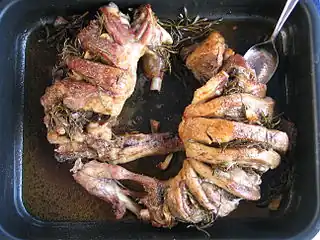
The holiday of Easter is associated with various Easter customs and foodways (food traditions that vary regionally). Preparing, coloring, and decorating Easter eggs is one such popular tradition. Lamb is eaten in many countries, mirroring the Jewish Passover meal.[1]
Some regional Easter dishes

In Greece, the traditional Easter meal is mageiritsa, a hearty stew of chopped lamb liver and wild greens seasoned with egg-and-lemon sauce. Traditionally, Easter eggs, hard-boiled eggs dyed bright red to symbolize the spilt Blood of Christ and the promise of eternal life, are cracked together to celebrate the opening of the Tomb of Christ.
Traditional Italian dishes for the Easter period are lamb (called "abbacchio" in Central Italy), cappello del prete, casatiello, Colomba di Pasqua, pastiera, penia, pizza di Pasqua and pizzelle. Eating lamb at Easter has a religious meaning.[2] The Paschal Lamb of the New Testament is in fact, for Christianity, the son of God Jesus Christ.[3] The Paschal Lamb, in particular, represents the sacrifice of Jesus Christ for the sins of humanity.[2] Eating lamb at Easter therefore commemorates the Death and Resurrection of Jesus.[2] In Central Italy the lamb is called abbacchio, a term that derives from the Latin baculum, or stick, which recalls the stick to which the lambs were tied before slaughtering them.[4] Colomba di Pasqua (English: "Easter Dove") is an Italian traditional Easter bread, the Easter counterpart of the two well-known Italian Christmas desserts, panettone and pandoro.
In Russia, red eggs, kulich and paskha are Easter traditions.
In Serbia, paretak are traditional Easter pastries.
In Ukraine, there are several traditional Easter foods including paska (bread) and cheesecake desserts.[5]
List of Easter foods
.jpg.webp)
Other Easter foods and food traditions include:
- Abbacchio
- Akvavit
- Awara broth, in French Guiana
- Babka (cake)
- Butter lamb
- Cappello del prete
- Casatiello
- Chocolate egg
- Carrot cake
- Chakapuli
- Colomba di Pasqua
- Cozonac
- Easter biscuit
- Easter bread
- Easter breakfast (see Polish cuisine#Easter breakfast)
- Easter bunny (often of the chocolate variety)
- Easter eggs
- Hot cross bun
- Fanesca, in Ecuador
- Feseekh, in Egypt
- Flaouna
- Easter Ham
- Koulourakia
- Kulich
- Leib
- Mämmi
- Ma'amoul
- Mazurek (cake)
- Pão-de-Ló and "Folar" in Portugal
- Paretak pastries
- Paska (bread)
- Paskha
- Pastiera
- Peeps
- Penia
- Pesaha Appam
- Pinca
- Pizza di Pasqua
- Pizzelle
- Pogaca (bread)
- Salted herring
- Sárgatúró in Hungary
- Simnel cake
- Šoldra
- Święconka
- Tsoureki, sometimes lined with red Easter eggs
- Habichuelas con dulce, in Dominican Republic
See also
References
- ↑ Traditional Easter Foods From Around the World
- 1 2 3 "Il simbolismo dell'agnello pasquale". lacucinaitaliana.it (in Italian). Retrieved 26 December 2022.
- ↑ "La Sacra Bibbia" (in Italian). Retrieved 26 December 2022.
- ↑ "La triade golosa del Natale italiano: cappone, abbacchio e capitone". lacucinaitaliana.it (in Italian). Retrieved 26 December 2022.
- ↑ Ukrainian Easter dinner
.jpg.webp)

